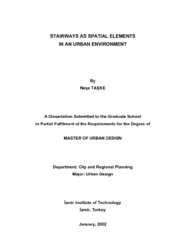Please use this identifier to cite or link to this item:
https://hdl.handle.net/11147/3763Full metadata record
| DC Field | Value | Language |
|---|---|---|
| dc.contributor.advisor | Gencel, Ziya | en |
| dc.contributor.author | Taşke, Neşe | - |
| dc.date.accessioned | 2014-07-22T13:52:19Z | - |
| dc.date.available | 2014-07-22T13:52:19Z | - |
| dc.date.issued | 2002 | en |
| dc.identifier.uri | http://hdl.handle.net/11147/3763 | - |
| dc.description | Thesis (Master)-Izmir Institute of Technology, City and Regional Planning, Izmir, 2002 | en |
| dc.description | Includes bibliographical references (leaves: 185-189) | en |
| dc.description | Text in English; Abstract: Turkish and English | en |
| dc.description | xvi, 189 leaves | en |
| dc.description.abstract | This study is focused on determining the design criteria for creating livable and democratic stairways, which are a part of the public space, that would enhance social interactions by providing all day long safe and comfortable use by residents as well as passers-by through analysing the physical aspects in order to lay out the functional problems. Stairways, which at first were a symbol of power or were a path to gods, after the beginning of public life, sharing urban space, circulation, pedestrian movement, created paths that evolved through topographic obstacles to become connections between different levels that required new designs and arrangements.The intricate relation between stairways, street-life and urban social life leave the stairways neglected through the changes in public life where the streets filled with obstacles are becoming gateways to residences. On the other hand stairways in the past have always been urban spaces which housed social life with all its features by looking at evidence of works in literature, music and cinema through time. Street characteristics have an important role in the urban setting as they evolve with public life reflecting its social, cultural and economic status. Because of the above reasons outdoor spaces are to be designed considering the social, cultural properties, needs and requests of the residents. and passers-by.s keeping track of the harmony with the environment. The study, at this point, stresses that stairways, although cannot house all outdoor activities, are more than mere elements of between levels circulation elements due to their capacity of a bearing many functions. The necessity of considering the variety of behaviours, needs and requests of differing age and user groups when designing is another issue pointed out in this study. Although stairways have the advantage of being isolated from vehicle traffic they still pose problems to the handicapped and elderly. Inspite the unavailability of ramp implementation in some cases stairways are still the playground for kids.The case study area is Güzelyalı district in İzmir, which has a variety of stairways with different characteristics. The stairways in the area have been classified with reference to their functions in the past, and their evolved functions due to increase in population and wear in time. The current physical and social situation of these stairways have been analysed with observation, photographing, inquiries etc. These methods provided a stronger foundation for discriminating the needs and requirements of the users, by a participative approach, in order to put forward design methods that would create an environmental quality to reach these goals.The study states that stairways, in addition to being safe paths for necessary activities, should promote optional and social activities to take place on them. This can be obtained by designs that are motivating, exiting, implemented such that they are connected to other public spaces, enhance environmental quality with sensible use of design elements a outdoor furniture.Key words: urban space, public space, stairway, steps, pedestrian, stairway activities, access, social interaction, environment quality. | en |
| dc.language.iso | en | en_US |
| dc.publisher | Izmir Institute of Technology | en |
| dc.rights | info:eu-repo/semantics/openAccess | en_US |
| dc.subject.lcc | HT153. T37 2002 | en |
| dc.subject.lcsh | Public spaces | en |
| dc.subject.lcsh | City planning | en |
| dc.subject.lcsh | Staircases | en |
| dc.subject.lcsh | Pedestrian areas | en |
| dc.subject.lcsh | Environmental quality | en |
| dc.title | Stairways as spatial elements in an urban environment | en_US |
| dc.type | Master Thesis | en_US |
| dc.institutionauthor | Taşke, Neşe | - |
| dc.department | Thesis (Master)--İzmir Institute of Technology, City and Regional Planning | en_US |
| dc.relation.publicationcategory | Tez | en_US |
| item.languageiso639-1 | en | - |
| item.fulltext | With Fulltext | - |
| item.openairecristype | http://purl.org/coar/resource_type/c_18cf | - |
| item.openairetype | Master Thesis | - |
| item.grantfulltext | open | - |
| item.cerifentitytype | Publications | - |
| Appears in Collections: | Master Degree / Yüksek Lisans Tezleri | |
Files in This Item:
| File | Description | Size | Format | |
|---|---|---|---|---|
| T000002.pdf | MasterThesis | 23.92 MB | Adobe PDF |  View/Open |
CORE Recommender
Page view(s)
96
checked on Jul 22, 2024
Download(s)
106
checked on Jul 22, 2024
Google ScholarTM
Check
Items in GCRIS Repository are protected by copyright, with all rights reserved, unless otherwise indicated.